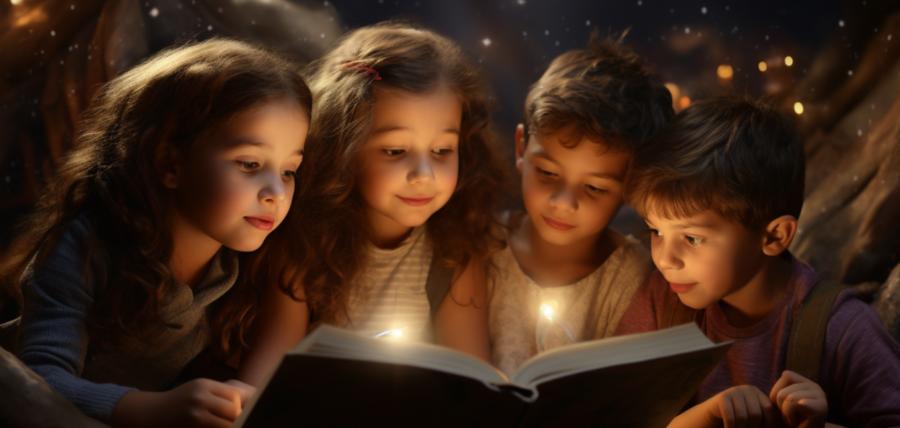The Art of Captivating Young Minds: A Guide to Engaging Educational Materials

Unleashing the Power of Storytelling
In the quest to captivate the sprightly minds of children, storytelling emerges as the knight in shining armor. It's not just about narrating tales; it's about weaving educational concepts into stories that could make even the most restless child sit still, eyes wide with wonder. Imagine teaching Pythagoras" theorem through the adventures of a triangle in a geometric land - suddenly, math isn't just numbers, but a saga of shapes!Visual Splendor: More Than Just Pretty Pictures
Visuals in educational materials should be more than just decorative. They need to be the visual equivalent of a double espresso shot to the brain. Bold colors, engaging characters, and interactive elements turn pages into playgrounds. It's about transforming a biology textbook into a jungle safari, where every turn of the page is a new animal waiting to be discovered.Interactivity: The Magic Wand of Engagement
Interactivity in educational materials isn't just a fancy feature; it's a necessity. It's the difference between a monologue and a conversation. Interactive elements like puzzles, quizzes, and games transform passive learning into an active quest. It's like turning a history lesson into a time-travel expedition, where every correct answer takes you closer to your destination.The Dance of Difficulty
Balancing the difficulty level in educational materials is a dance as delicate as ballet. Too easy, and the child's mind wanders to the next shiny object. Too hard, and frustration sets in. The key is to challenge but not overwhelm, like a video game that's hard to quit - you fail, you try again, and you learn without even realizing it.Humor: The Secret Sauce
Humor in educational materials is like that cool aunt who lets you eat ice cream for breakfast. It makes learning fun, approachable, and memorable. A joke here, a funny illustration there, and suddenly, the periodic table isn't just a bunch of symbols, but a party where Hydrogen and Oxygen are having a blast.Real-World Connections: Bridging the Gap
Linking educational content to the real world is like showing kids the secret door to Narnia in their wardrobe. It's about showing them the magic in the mundane. When a child realizes that the math problem they're solving is like calculating the score in their favorite sport, math becomes a game they want to play.Conclusion: Crafting a Masterpiece
Designing engaging educational materials for children is an art form. It's about understanding the rhythm of a child's curiosity and composing materials that resonate with their vibrant energy. It's a blend of storytelling, visual artistry, interactive elements, humor, and real-world connections - all coming together to create a symphony of learning that resonates with the young audience.Article kindly provided by penstripe.co.uk
Latest Articles
- Crafting Interiors That Help Music Truly Come Alive
- Why Packaging Design Matters Even for Digital Products
- Color Palettes That Evolve: Creating Schemes That Shift With Time of Day, Mood, or User Context
- Exploring Subtle Details Found in Quality Swiss Timepieces
- How Adaptive Cabin Environments Let Chauffeured Executives Shift Effortlessly Between Rest and Focus
- Jewellery as Identity Encryption: Choosing Symbols That Speak Only to You
- From Minimal to Maximal: Print Styles That Actually Fit Your Decor
- From Cathedrals to Conference Halls: How Venue Acoustics Change the Meaning of Music
- How to Photograph Big Celebrations Without Interrupting the Flow
- Selecting an SEO Company When Your Business is Design-Driven: What Creative Agencies Should Know
- Unexpected Light Sources That Make Photographers Look Clever
- Understanding the Emotional Grammar of Portrait Light
- Why the Humble Photo Booth is the Secret Glue of a Wedding Day
- Hues That Hug: Creating Calm, Focus, and Joy Through Sensory Colour
- How Monochrome Shifts Perception in Wildlife and Landscape Imagery
- Color Grading Secrets That Make It Look Like You Had a Lighting Crew
- Photography: Blending Environmental Portraiture Into Ordinary Home Spaces
- Charity Comm's Greatest Hits and How to Actually Fix Them
- Pop-Up Studio on the Move Makes Mobile Portrait Setups Work Anywhere
- Time Proof Your Visual Stories With Techniques That Outlive Trends
- Architecture
- Graphic Design
- Web Design
- Industrial Design
- Interior Design
- Fashion Design
- Photography
- Product Design
- UI/UX Design
- Landscape Design
- Animation
- Industrial Engineering
- Packaging Design
- Branding and Identity Design
- Exhibit Design
- Advertising Design
- Typography
- Motion Graphics
- Sustainable Design
- User Research
- Fashion Merchandising
- Film and Video Production
- UX Writing
- Environmental Design
- Print Design
- Interaction Design
- Art Direction
- Textile Design
- Game Design
- Virtual Reality (VR) Design
- General Design Principles
- Event and Wedding Design

